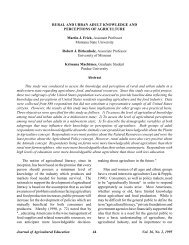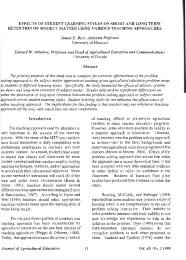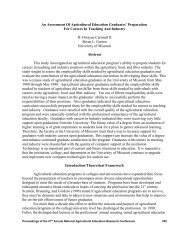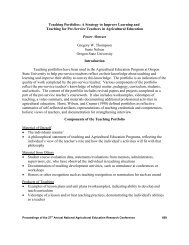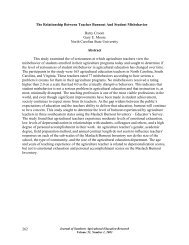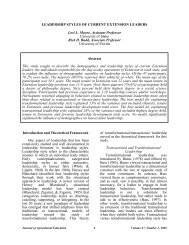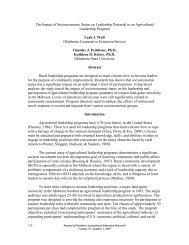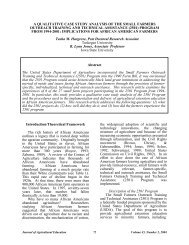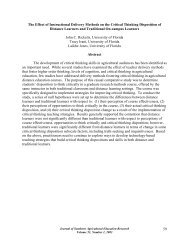Relationships Between Critical and Creative Thinking - Agricultural ...
Relationships Between Critical and Creative Thinking - Agricultural ...
Relationships Between Critical and Creative Thinking - Agricultural ...
Create successful ePaper yourself
Turn your PDF publications into a flip-book with our unique Google optimized e-Paper software.
The second research objective was to determine the amount of variance in creativethinking ability explained by critical thinking disposition. Five multiple linear regressionanalyses were utilized, with raw TTCT scores as the dependent variable, <strong>and</strong> CCTDI subscalesas the independent variables. Although none of the analyses were statistically significant, criticalthinking disposition accounted for 24% of the variance in resistance to premature closure(F=1.96, p=.08), 5% of the variance on fluency (F=.35, p=.93), 8% of the variance onabstractness (F=.55, p=.78); 2% on originality (F=.49, p=.83); <strong>and</strong> 1% on elaboration (F=.06,p=.99).The final research objective was to examine the relationships between creative thinkingability <strong>and</strong> gender. Low to negligible (Davis, 1971) bivariate relationships were found betweengender <strong>and</strong> resistance to premature closure (r=.07), fluency (r=-.03), abstractness (r=.24),originality (r=-.11), <strong>and</strong> elaboration (r=.15).Conclusion <strong>and</strong> ImplicationsIt appears that the collegiate educational experience has had little effect upon the students’ability to be creative or their disposition to think critically. Teaching students to rememberfactual information <strong>and</strong> return it in the form of an examination is the prevalent teaching modeemployed in secondary <strong>and</strong> post-secondary institutions today. Teaching thinking skills is adifficult <strong>and</strong> much different endeavor. Teaching to promote thinking takes more time to prepare,is difficult to plan, <strong>and</strong> limits the amount of content “taught.” Teachers can no longer beinformation givers. Students must learn thinking <strong>and</strong> reasoning skills to reach their fullestpotential in today's society (Meyers, 1986).The “more information is better” attitude unfortunately prevails in modern education. Thisis unfortunate considering that often the factual matter has a relatively short life span withstudents (Terezini, Springer, Pascarella, & Nora, 1993). When coupled with the fact thatinformation learned today quickly becomes outdated, is it any wonder that our students strugglewhen they reach the work place? Good thinking skills will not develop on their own, they mustbe taught (Beyer, 1987). Teaching students to think must be a priority of our schools today. Inany thought process we engage in both critical <strong>and</strong> creative thinking (Beyer, 1987).The term critical thinking is common in educational, psychological, <strong>and</strong> philosophicalcircles today. Employers, parents, administrators, <strong>and</strong> students themselves want critical thinkingskills developed in today's graduate. Developing critical thinking skills is not a new idea.Osborne (1932, p.402) stated that, "…it is assumed that development of thought power is one ofthe major aims of education." Dressel <strong>and</strong> Mayhew (1954) believed that educational institutionswere responsible for teaching students to go beyond the simple mental activities of recall <strong>and</strong>restatement of ideas <strong>and</strong> facts to the higher-level skills <strong>and</strong> habits involved in critical thinking.182 Journal of Southern <strong>Agricultural</strong> Education ResearchVolume 51, Number 1, 2001




